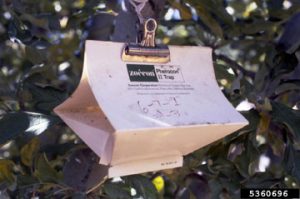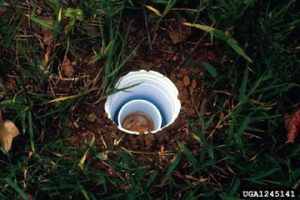The use of monitoring traps is highly recommended for certain insects. These devices provide ongoing coverage and are a must in spaces that are unseen or inaccessible. They include sticky traps and pheromone traps among others.
Sticky Traps: Some insects are attracted to bright yellow, blue or other colors so they can be caught on colored sheets of plastic or cardboard that is coated with glue. Sticky traps are commonly used as a monitoring tool in greenhouses and orchards. By regularly checking the sticky traps, the initial presence of a potentially damaging insect population can be detected.
-
- Yellow sticky traps attract adult whiteflies, flower thrips, fungus gnats, and leafminers
- Bright blue traps attract flower thrips
- Sticky traps are available for indoor structural pests as well.

Pheromone Traps: Individually packaged pheromone attractant traps are available for monitoring some species of insects. The traps are baited with a lure that mimics the odor given off by females to attract males for mating. The traps are used to find out when the main flights of adult insects occur so that management tactics can be timed to have the greatest effect. For example, orchard growers use pheromone traps to time codling moth sprays so that they are used when the most moth eggs are hatching into caterpillars.
 Plastic pitfall traps are used for crawling pests in the field as well as in stored grain bins. The species and number of insects found in a trap should be recorded and charts constructed so that changes in population size can be noticed.
Plastic pitfall traps are used for crawling pests in the field as well as in stored grain bins. The species and number of insects found in a trap should be recorded and charts constructed so that changes in population size can be noticed.
Light traps (black light traps) are attractive to some insects, but pheromone traps offer increased flexibility in deployment and specificity.
A note on insect monitoring traps – the purpose of traps used to monitor insects is just that – to monitor. A common misconception is that a monitoring trap such as a sticky card will capture all pests in a location and reduce the population. This is not likely to be the case. It is important to check monitoring traps on a schedule and replace them with new traps to ensure data is not missed.